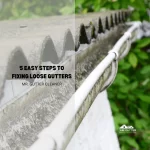Ice dams pose a significant risk to home maintenance, particularly in regions experiencing heavy snowfall. These ice formations occur when heat escapes from the attic, melting the snow on the roof, which then refreezes at the eaves, creating dams that prevent proper drainage. The consequences of ice dams can be severe, including damage to roofs, gutters, and even the interior of homes through water intrusion.
Understanding the formation and prevention of ice dams is crucial for homeowners to protect their property. Effective prevention focuses on minimizing heat loss through proper attic insulation, ventilation, and sealing air leaks.
Insulation keeps heat within living spaces, preventing it from warming the roof. Ventilation helps to remove the heat that does escape, and sealing air leaks prevents warm air from reaching the attic in the first place.
Beyond these steps, removing snow from the roof can also prevent ice dam formation, though it requires careful techniques to avoid roof damage.
For those facing persistent issues, professional solutions and long-term strategies, such as installing heat cables or upgrading heating systems, offer additional prevention measures.
Recognizing the importance of proactive maintenance, homeowners can significantly reduce the risk of ice dams and safeguard their homes against potential damage. This introduction underscores the importance of comprehensive home maintenance strategies to prevent ice dams, aligning with the broader goal of preserving home integrity and comfort.
What Are Ice Dams?
Ice dams are barriers of ice that form at the edge of a roof and prevent melting snow from draining off. These dams occur when heat escapes from the home, melts snow on the roof, and the water refreezes at the roof’s edge.
Understanding the Formation of Ice Dams
The process starts when heat from the attic melts the snow on the roof. The melted snow flows down to the roof’s edge, where it refreezes because this area is not as warm. This cycle creates a ridge of ice at the eaves, blocking further melting snow from draining. Factors contributing to their formation include poor attic insulation and inadequate ventilation.
Table of Contents:
Why Are Ice Dams a Problem for Your Home?
Ice dams can cause significant damage. The water that backs up behind the dam can leak into a home and damage walls, ceilings, insulation, and other interior areas. Over time, this can lead to mold and mildew growth, further endangering the home’s structure and the health of its inhabitants. Additionally, ice dams can strain and damage gutters and downspouts, leading to expensive repairs. Understanding and addressing the root causes of ice dam formation is crucial for maintaining the integrity and safety of a home.
How Do Ice Dams Form?
The formation of ice dams is primarily due to uneven roof temperatures. This discrepancy occurs when warm air in the attic heats the roof, causing snow to melt despite cold outdoor temperatures. As the melted snow flows down the roof, it reaches the colder edge and eaves, where it refreezes into ice, forming a dam that traps further melting snow.
The Role of Heat Loss in Ice Dam Formation
Heat loss from a home’s living spaces into the attic is a key contributor to ice dam formation. Inadequate insulation and air leaks allow warm air to escape, heating the underside of the roof and melting the snow on top. This melted snow then flows towards the eaves, which are cooler because they extend beyond the house’s warm interior, where it refreezes into ice.
The Impact of Snowfall on Ice Dam Development
Snow acts as an insulator. A thick layer of snow on a roof can trap heat escaping from the attic, exacerbating the roof’s uneven temperature. The warmth beneath the snowpack melts the bottom layer of snow, causing water to flow down to the eaves and freeze. Heavy snowfall can thus accelerate the formation of ice dams by increasing the insulation effect and the amount of melting snow.
Identifying the Risks of Ice Dams
Ice dams pose several risks to homes, primarily through water damage and the potential for mold and structural issues. Understanding these risks is crucial for homeowners to prioritize prevention and maintenance efforts effectively.
Potential Damage to Roofs and Gutters
Ice dams can cause significant damage to roofing materials and gutter systems. The weight of accumulated ice can strain gutters, leading to detachment or deformation. Moreover, water pooling behind the ice dam can seep under shingles and into the roof deck, causing rot, mold, and leaks that may compromise the roof’s integrity and lead to costly repairs.
Risks to Indoor Air Quality and Mold Growth
The moisture intrusion caused by ice dams can have adverse effects on indoor air quality. As water penetrates insulation and interior spaces, it creates conditions conducive to mold and mildew growth. These fungi can spread quickly within walls and ceilings, posing health risks to occupants and requiring extensive remediation. Additionally, moisture can damage insulation, reducing its effectiveness and leading to higher heating costs.
Preventive Measures for Ice Dams
Preventing ice dams involves addressing their root causes: uneven heating of the roof and inadequate insulation and ventilation in the attic. Implementing specific measures can significantly reduce the risk of ice dam formation, protecting the home from potential damage.
Improving Attic Insulation
Enhancing attic insulation helps maintain consistent temperatures throughout the roof, preventing the melting and refreezing cycle that leads to ice dams. Homeowners should aim for an insulation R-value that meets or exceeds local building codes, focusing on sealing gaps around light fixtures, vent pipes, and chimney chases, which can leak warm air.
Enhancing Ventilation in the Attic
A well-ventilated attic helps remove the heat that insulation cannot entirely block. Proper ventilation allows cool air to enter the attic at the eaves and exit at the ridge, promoting a uniform roof temperature.
Sealing Air Leaks
Sealing leaks between the living space and the attic is critical in preventing warm air from reaching the roof. Common leak sources include attic hatches, recessed lighting, and ductwork.
Snow Removal Techniques to Prevent Ice Dams
Removing snow from the roof is a direct method to prevent ice dam formation by eliminating the source of the meltwater. It’s important to approach snow removal carefully to avoid damaging roofing materials.
Safe Roof Snow Removal Methods
Using a roof rake with a long extension handle allows homeowners to remove snow without climbing onto the roof, reducing the risk of personal injury and roof damage. It’s crucial to pull snow down in the direction of the roof’s slope and to avoid contact with the roofing materials to prevent scraping or dislodging shingles.
Tools and Equipment for Removing Snow from Roofs
- Roof Rakes: Specially designed with soft, non-abrasive edges to safely remove snow while standing on the ground.
- Telescoping Poles: Extendable poles can increase reach and allow for the removal of snow from higher sections of the roof without the need for a ladder.
- Calcium Chloride Socks: These can be placed on the roof to create channels through the ice, allowing trapped water to drain off. It’s important to use calcium chloride rather than rock salt, which can damage roofing materials and plants below.
Professional Solutions for Ice Dam Prevention
For homeowners facing persistent ice dam issues or those seeking to prevent problems before they start, professional solutions offer a comprehensive approach. Experts in ice dam prevention can assess a home’s specific vulnerabilities and implement strategies tailored to its needs.
When to Call a Professional for Ice Dam Removal
It’s advisable to contact a professional when ice dams have already formed and pose an immediate risk of damage. Professionals have the tools and techniques to safely remove ice dams without damaging the roof. Signs that professional help is needed include large icicles forming at the eaves, water stains on ceilings or walls, and ice buildup in gutters and downspouts.
Selecting a Reliable Ice Dam Prevention Service
Choosing the right service provider is crucial. Homeowners should look for companies with specific experience in ice dam prevention and removal. Essential criteria include:
- Licensing and Insurance: Ensure the company is licensed to perform roofing or ice dam removal work and carries liability insurance.
- Experience: Look for providers with a track record of successfully managing ice dam issues in similar climates and homes.
- Techniques and Tools: The best services use steamers rather than harsh chemicals or mechanical devices that can damage roofing materials.
Long-Term Strategies to Prevent Ice Dams
Adopting long-term strategies to prevent ice dams is essential for homeowners looking to protect their properties from water damage, mold, and other related issues. These strategies focus on addressing the root causes of ice dam formation and ensuring homes are well-equipped to handle winter conditions.
Installing Heat Cables: Pros and Cons
Heat cables, or heat tape, can be installed along the roof’s edge and in gutters and downspouts to prevent ice from forming. While they offer a proactive approach to ice dam prevention, they come with both advantages and disadvantages.
- Pros: Heat cables can effectively prevent ice dams by creating channels for meltwater to flow off the roof. They’re especially useful in homes where architectural features or shade patterns contribute to uneven roof temperatures.
- Cons: Heat cables increase energy consumption and can be seen as a temporary fix that doesn’t address underlying insulation or ventilation issues. Regular maintenance is required to ensure they function correctly.
Upgrading Your Home’s Heating System
Improving the efficiency of a home’s heating system can indirectly help prevent ice dams by reducing the amount of heat escaping into the attic. High-efficiency furnaces, better duct insulation, and programmable thermostats can minimize the warm air reaching the roof, thus reducing snow melt.
- Benefits: Enhanced heating system efficiency can lower energy bills and improve overall home comfort, besides contributing to ice dam prevention.
- Considerations: Upgrades can require a significant investment, so it’s important to weigh the costs against the potential long-term savings and benefits related to ice dam prevention.
Frequently Asked Questions About Ice Dam Prevention
Addressing common questions about ice dam prevention can help homeowners better understand the issue and take effective steps to protect their homes. This section compiles and answers the most frequently asked questions, providing concise and informative guidance.
Can Ice Dams Cause Permanent Roof Damage?
Yes, ice dams can cause permanent roof damage if not addressed promptly. The weight of the ice can strain gutters and roof structures, while water backing up behind the dam can seep under shingles, leading to rot, mold, and leaks that compromise the roof’s integrity.
How Often Should I Inspect My Roof for Ice Dam Prevention?
Homeowners should inspect their roofs at least twice a year—once in the fall before winter sets in and again in the spring. Look for signs of wear, damage, and potential areas where ice dams could form. Regular inspections can identify issues early, allowing for timely repairs and prevention measures.


